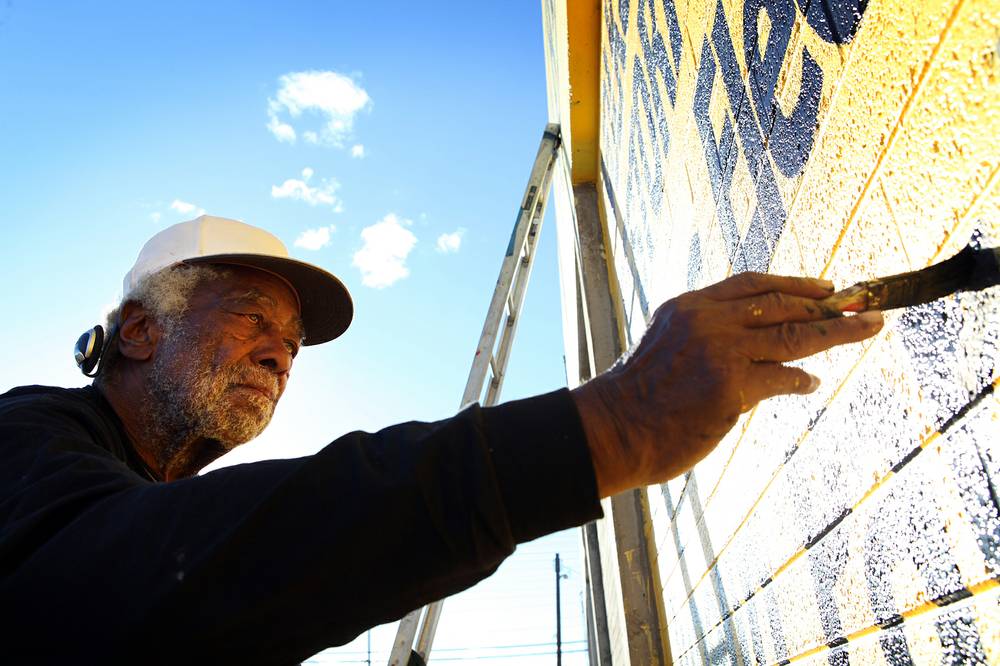King Richard’s realm is not a conventional one. It is the weathered sides of Downtown cinder block, his reign now decades old, even if few have noticed. The King has done as much to color our perceptions of Downtown Las Vegas as any star architect.
The King is a sign painter, and his signature 1950s technique and style have given many of Downtown’s buildings — on Main Street, for instance — their retro feel. This explains why, in a city that destroys, many Downtown buildings feel like such wonderfully preserved relics.
The key is to notice. Amid the architectural junk, the power lines and billboards, if you look closely, you’ll see the King’s work — classic block lettering alternating with fancy tilted script. “Quality Upholstery.” “Carpets Galore." “Main Street Furniture & Upholstery.”
Driving Downtown, you’ll find yourself craning your neck, spotting his hand-painted signs on the sides of buildings everywhere. Perhaps half are his handiwork. I confess that I didn’t notice until I met Geoffrey Ellis and Bryan McCormick, two photographers who are documenting Downtown, and its signs in particular, for the Vegas Vernacular Project.
For months they had been looking for King Richard, whose whereabouts were unknown. Rumors abounded. He was ill or worse. For Ellis and McCormick, the King had become an almost apocryphal, mystical figure.
“We always seem just one step behind him,” McCormick says, lamenting what would happen without the King and his fellow sign painters: vinyl banners with flat, dull computer-generated lettering. “I think they’re doing it just to hurt me,” he jokes.
So one day, recently, we set out to find the King. Perhaps Weekly photographer Leila Navidi and I are a talisman, because after a few clues rounded up from neighborhood business owners and artists, the King is found!
He’s in the middle of a big job at Classic V Dubs, the Volkswagen restoration shop on Main Street, giving his yellow background and black letters a freshening up. The solidity and constancy of his fonts and technique stand in remarkable contrast to his peripatetic life, a story of classic American wandering that he tells us from atop a ladder next to a small shopping cart filled with paints and brushes.
Born Richard Harris in March 1936, he learned sign painting in the 12th grade at San Diego High School from Mrs. Walters. “I still think about her,” he says.
He also took silk screening and art — abstraction is his favorite — and he silkscreened most of the 1,200 yearbooks for his school. His mother was afraid he’d get caught up in gang life, so after graduation, she took him to join the Marines, where he learned discipline during his three-year enlistment.
Out in ’56, he moved to LA, where he went to sign-painting school. All of LA was like a sign-painting campus in those days, he says, old buildings ripe for hand-painted signs. It was like parts of Downtown Las Vegas today.
Back at Classic V Dubs, he’s painting the big “Volkswagen” letters, which he likes to mash together. The King says the Helvetica font is his biggest influence. McCormick thinks he may have found another influence in an old book, an obscure font called “Belair Casual” that seems to resemble the King’s work.
The King was in LA until ’65, when he left because of the riots. “I felt like LA was falling apart — like it was a war zone.” He next moved to Berkeley, Calif., where he lived through the anti-war movement and the crazy 1970s. There were lovers and children; eventually he would have two boys and a girl and another daughter who died at birth in 1975. In the late ’70s, he left Berkeley and went to Guadalajara, Mexico. “Just tracking down some people doing art,” he explains. His car was impounded, so he took the bus to Laredo, Texas, which was rich with oil money. “I was coming back on the bus, and I’d never seen that part of the country, so let’s check it out.”
The King stayed until 1984, when the Texas oil economy tanked. Then he was off to New Orleans for the ’84 World’s Fair. He earned the name King Richard at a Mardi Gras parade, and it stuck.
He loved New Orleans, but there wasn’t enough work, so he drove west. His truck caught fire in Winslow, Ariz. — 340 miles outside Las Vegas — and he’s been here ever since. He says he likes to bet games at LVH when he’s flush.
King Richard gets $200 for the Classic V Dubs job, which will take a couple of days. Business is booming, he says, and he’s working four or five days a week even as he’s approaching 80. For years there was hardly any competition, and he estimates that 60 percent of hand-painted Downtown is his. You can spot them: The King’s “s” has a fat bottom, like an oblong egg. His ampersands and exclamation points and the occasional dotted “i” are his real signatures. Someone once gave him a book full of ampersands, and Downtown is the lucky beneficiary. The bottom of the exclamation points resemble the head of a cat or perhaps a coiled snake. The King says he thinks he got it from a guy in LA.
It requires a delicate hand, he says, as he works the brush like he’s stroking the soft cheek of an infant. When he first started, he would practice that technique for hours.
“That’s what you have to practice on — the delicate parts.”


Previous Discussion: